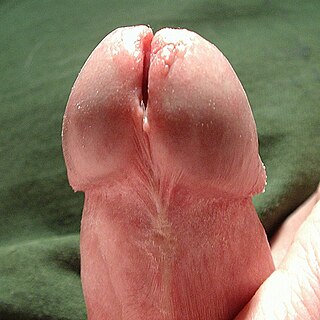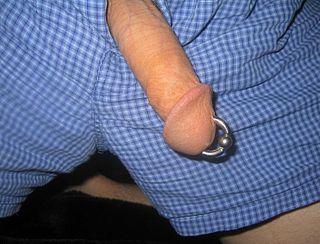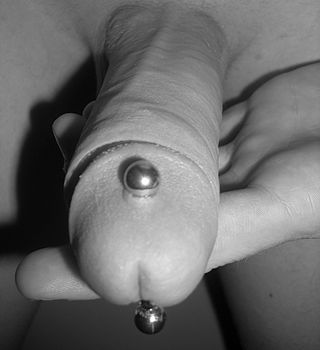| Ampallang | |
|---|---|
 | |
| Location | Glans |
| Jewelry | Straight barbell |
| Healing | 5 months |
The palang (Iban : crossbar ) or ampallang is a male genital piercing that penetrates horizontally through the entire glans of the penis. [1]
| Ampallang | |
|---|---|
 | |
| Location | Glans |
| Jewelry | Straight barbell |
| Healing | 5 months |
The palang (Iban : crossbar ) or ampallang is a male genital piercing that penetrates horizontally through the entire glans of the penis. [1]

Penis piercings of proto-Malay origin predated European contact with tribes in (among others) the Philippines [2] : 57–58 and Borneo (Dayak people). Thomas Cavendish [2] : 158 claims that in the Philippines the practice was an invention of the women to prevent sodomy (the Philippines variant included a spur). [2] : 58
In Western culture, the ampallang became popular along with the many genital piercings practiced amongst the gay BDSM community prior to the establishment of the body piercing industry in the 1980s and 1990s. Due to its supposed authenticity, this piercing is closely associated with the modern primitive movement but anatomy and use of a palang differs drastically from a modern ampallang. Indeed, traditional palang design is simply a pin used to attach a wooden glans cape[ clarification needed ] extension to the penis. [3]
The piercing may be transurethral (passing through the urethra) and named as the European ampallang, whereas the American ampallang is placed horizontally above the urethra, generally back toward the corona. [4] A variant on this piercing is the shaft ampallang, which penetrates the shaft of the penis horizontally at any point along its length. The counterpart to this piercing is the apadravya, which penetrates the glans vertically. The combination of an ampallang and an apadravya is sometimes referred to as the magic cross.
Ampallang is an advanced piercing, and the procedure can be extremely painful. Full healing usually takes between four and six months, but can take a year or more in an American ampallang.
The primary health issues related to this piercing are during the procedure itself and during the healing process. Depending on the placement, there can be a significant amount of blood loss, both during the procedure and during the initial healing process. The measurement for the piercing jewelry is typically done by the receiver in private on his erect penis, while the actual piercing is done on his flaccid penis. The long healing process requires that the bearer abstain from sexual intercourse for a lengthy period of time, on the order of six weeks to six months.
It is possible for this piercing to injure or damage the teeth and soft palate of the giving party during oral sex.
If this piercing is transurethral ("European"), it can divert the flow of urine, forcing the bearer to sit down or take other measures during urination. The piercing will leave a tube of scar tissue, which will remain even if the jewelry is removed and the piercing allowed to heal.
Ampallang, once healed, is often pleasurable to the bearer because it stimulates the internal penis tissues. [5]
Straight barbells are almost exclusively worn in ampallangs, both initially and after they are healed. Jewelry must be long enough to accommodate the expansion of the penis during erection, at the risk of significant discomfort for the wearer. After initial healing the piercing can be stretched and larger jewelry can be inserted, reaching sizes above 10 mm in diameter.

The clitoris is a female sex organ present in mammals, ostriches, and a limited number of other animals. In humans, the visible portion – the glans – is at the front junction of the labia minora, above the opening of the urethra. Unlike the penis, the male homologue (equivalent) to the clitoris, it usually does not contain the distal portion of the urethra and is therefore not used for urination. In most species, the clitoris lacks any reproductive function. While few animals urinate through the clitoris or use it reproductively, the spotted hyena, which has an especially large clitoris, urinates, mates, and gives birth via the organ. Some other mammals, such as lemurs and spider monkeys, also have a large clitoris.

The Prince Albert (PA) is a penis piercing which extends from the urethra to the underside of the glans. It is one of the most common male genital piercings. The related reverse Prince Albert piercing enters through the urethra and exits through a hole pierced in the top of the glans.

In male human anatomy, the glans penis, commonly referred to as the glans, is the bulbous structure at the distal end of the human penis that is the human male's most sensitive erogenous zone and primary anatomical source of sexual pleasure. The glans penis is present in the male reproductive organs of humans and most mammals where it may appear smooth, spiny, elongated or divided. It is externally lined with mucosal tissue, which creates a smooth texture and glossy appearance. In humans, the glans is located over the distal ends of the corpora cavernosa and is a continuation of the corpus spongiosum of the penis. At the summit appears the urinary meatus and at the base forms the corona glandis. An elastic band of tissue, known as the frenulum, runs on its ventral surface. In men who are not circumcised, it is completely or partially covered by a fold of skin called the foreskin. In adults, the foreskin can generally be retracted over and past the glans manually or sometimes automatically during an erection.

Genital modifications are forms of body modifications applied to the human sexual organs, such as piercings, circumcision, or labiaplasty.

A clitoral hood piercing is a female genital piercing through the clitoral hood surrounding the clitoris. In addition to being an adornment, a clitoral hood piercing can enhance sexual pleasure during masturbation, foreplay and intercourse. In an empirical study at the University of South Alabama, the authors reported a positive relationship between vertical clitoral hood piercings and desire, frequency of intercourse, and sexual arousal. There are two main types of clitoral hood piercing: the vertical clitoral hood (VCH) piercing and the horizontal clitoral hood (HCH) piercing. As the names indicate, the difference is in the direction the piercing is oriented in the skin above the clitoris. Neither of these piercings penetrates the clitoris itself, although in common parlance they are sometimes called "clit" piercings. The deep hood piercing is a variation of the clitoral hood piercing that passes deeper through the clitoral hood.
Infibulation is the ritual removal of the external female genitalia and the suturing of the vulva, a practice found mainly in northeastern Africa, particularly in Djibouti, Eritrea, Ethiopia, Somalia, and Sudan. The World Health Organization refers to the procedure as Type III female genital mutilation. Infibulation can also refer to placing a clasp through the foreskin in men.

Princess Albertina is a female genital piercing, where a ring enters the urethra and exits through the top of the vagina. Anne Greenblatt described the Princess Albertina to Ralph H. in 1995 as a "relatively new and experimental piercing." Its name comes from the fact that it is analogous to the male Prince Albert piercing.

The prince's wand is a piece of body piercing jewelry. It consists of a hollow tube with a threaded cap at the end. The tube is inserted into the urethra, and a stem is inserted through a Prince Albert piercing and into another threaded hole on the side of the tube. The general shape is similar to a police nightstick. The little side stem holds the tube in place. The threaded cap, often just a ball, can be removed so the wearer can urinate through the hollow tube without having to remove the jewelry.

A meatotomy is a form of penile modification in which the underside of the glans is split, extending the urinary meatus. The procedure may be performed by a doctor to alleviate meatal stenosis or urethral stricture.

A frenum piercing is a type of body piercing located on the underside of the shaft of the penis. A series of parallel frenum piercings is known as a frenum ladder. A frenum ladder may be extended to include lorum piercings, hafada piercings and guiche piercings.

A dydoe is a type of male genital piercing that passes through the ridge of the glans on the head of the penis. They are often done in pairs. Less often, a "king's crown" is where several dydoes are placed around the head of the penis. The jewelry is usually a 12 gauge, straight barbell with a ball on either end, although a ring may be used at a higher chance of rejection. A deep dydoe is one that uses a longer barbell and exits near the tip of the penis.

Genital piercing is a form of body piercing that involves piercing a part of the genitalia, thus creating a suitable place for wearing different types of jewellery. Nevertheless, the term may also be used pars pro toto to indicate all body piercings in the area of the anus, perineum, penis, scrotum, and vulva, including piercings such as anal, guiche, and pubic that do not involve perforation of genitalia. Genital piercings can be done regardless of sex, with various forms of piercings available. The main motive is beautification and individualization; in addition, some piercings enhance sexual pleasure by increasing stimulation. Pre-modern genital piercings is most culturally widespread in Southeast Asia, where it has been part of traditional practice since ancient times. Records of genital piercing are found in the Kama Sutra.

A hafada piercing is a surface piercing anywhere on the skin of the scrotum. Piercings on the scrotal raphe or "seam" of the scrotum are common. This piercing does not penetrate deep into the scrotum, and due to the looseness and flexibility of the skin in that area, does not migrate or reject as much as many other surface piercings. The main motives are beautification and individualization. A piercing that passes through the scrotum, from front-to-back, or from side-to-side, is known as a transscrotal piercing. Multiple hafada piercings are not uncommon, often as an extension of a frenum ladder or Jacob's Ladder, which is a series of piercings from the frenulum to the scrotum.

A genital tubercle or phallic tubercle is a body of tissue present in the development of the reproductive system. It forms in the ventral, caudal region of mammalian embryos of both sexes, and eventually develops into a primordial phallus. In the human fetus, the genital tubercle develops around week 4 of gestation, and by week 9 becomes recognizably either a clitoris or penis. This should not be confused with the sinus tubercle which is a proliferation of endoderm induced by paramesonephric ducts. Even after the phallus is developed, the term genital tubercle remains, but only as the terminal end of it, which develops into either the glans penis or the glans clitoridis.

The Reverse Prince Albert piercing (RPA) is a form of male genital piercing.

A clitoris piercing is a genital piercing placed directly through the head (glans) of the clitoris itself. It is a relatively uncommon piercing by choice because of the potential for nerve damage, and because many may find it too stimulating to allow the constant wearing of a small ring or barbell. Most piercing studios will refuse to do a clitoral piercing. It is often confused with the more common clitoral hood piercing, which pierces only the hood covering the clitoral glans, allowing the jewelry to make only occasional contact with the most sensitive area.

Deep shaft piercings are piercings which pass through the penile shaft. They are most commonly seen in the form of deeply placed ampallangs, apadravyas, and reverse shaft Prince Alberts. They are more rare piercings due to associated pain, difficulty, bleeding and long healing times. Common placement is directly behind the head of the penis, but they can be placed farther back.

In human anatomy, the penis is an external male sex organ that additionally serves as the urinary duct. The main parts are the root (radix); the body (corpus); and the epithelium of the penis including the shaft skin and the foreskin (prepuce) covering the glans penis. The body of the penis is made up of three columns of tissue: two corpora cavernosa on the dorsal side and corpus spongiosum between them on the ventral side. The human male urethra passes through the prostate gland, where it is joined by the ejaculatory duct, and then through the penis. The urethra traverses the corpus spongiosum, and its opening, the meatus, lies on the tip of the glans penis. It is a passage both for urination and ejaculation of semen.
The development of the reproductive system is the part of embryonic growth that results in the sex organs and contributes to sexual differentiation. Due to its large overlap with development of the urinary system, the two systems are typically described together as the urogenital or genitourinary system.

The apadravya, like the ampallang, is a genital piercing that passes through the glans. While the ampallang passes horizontally through the glans, the apadravya passes vertically through the glans from top to bottom, almost always placed centrally and passing through the urethra. It can be paired with an ampallang to form the magic cross. Off-center apadravyas are also possible, wherein the piercing is deliberately offset, yet usually still passes through the urethra. The piercing is often done on a slightly forward angle to the hips.